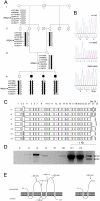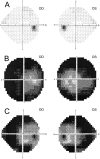Autosomal recessive retinitis pigmentosa with early macular affectation caused by premature truncation in PROM1
- PMID: 20042663
- PMCID: PMC2868491
- DOI: 10.1167/iovs.09-4857
Autosomal recessive retinitis pigmentosa with early macular affectation caused by premature truncation in PROM1
Abstract
Purpose: To identify the genetic basis of a large consanguineous Spanish pedigree affected with autosomal recessive retinitis pigmentosa (arRP) with premature macular atrophy and myopia.
Methods: After a high-throughput cosegregation gene chip was used to exclude all known RP and Leber congenital amaurosis (LCA) candidates, genome-wide screening and linkage analysis were performed. Direct mutational screening identified the pathogenic mutation, and primers were designed to obtain the RT-PCR products for isoform characterization.
Results: Mutational analysis detected a novel homozygous PROM1 mutation, c.869delG in exon 8 cosegregating with the disease. This variant causes a frameshift that introduces a premature stop codon, producing truncation of approximately two-thirds of the protein. Analysis of PROM1 expression in the lymphocytes of patients, carriers, and control subjects revealed an aberrant transcript that is degraded by the nonsense-mediated decay pathway, suggesting that the disease is caused by the absence of the PROM1 protein. Three (s2, s11 and s12) of the seven alternatively spliced isoforms reported in humans, accounted for 98% of the transcripts in the retina. Given that these three contained exon 8, no PROM1 isoform is expected in the affected retinas.
Conclusions: A remarkable clinical finding in the affected family is early macular atrophy with concentric spared areas. The authors propose that the hallmark of PROM1 truncating mutations is early and severe progressive degeneration of both rods and cones and highlight this gene as a candidate of choice to prioritize in the molecular genetic study of patients with noncanonical clinical peripheral and macular affectation.
Figures




Similar articles
-
An intronic deletion in the PROM1 gene leads to autosomal recessive cone-rod dystrophy.Mol Vis. 2015 Dec 8;21:1295-306. eCollection 2015. Mol Vis. 2015. PMID: 26702251 Free PMC article.
-
Severe retinitis pigmentosa mapped to 4p15 and associated with a novel mutation in the PROM1 gene.Hum Genet. 2007 Nov;122(3-4):293-9. doi: 10.1007/s00439-007-0395-2. Epub 2007 Jun 29. Hum Genet. 2007. PMID: 17605048
-
Cone-rod dystrophy and a frameshift mutation in the PROM1 gene.Mol Vis. 2009 Aug 28;15:1709-16. Mol Vis. 2009. PMID: 19718270 Free PMC article.
-
The PROM1 mutation p.R373C causes an autosomal dominant bull's eye maculopathy associated with rod, rod-cone, and macular dystrophy.Invest Ophthalmol Vis Sci. 2010 Sep;51(9):4771-80. doi: 10.1167/iovs.09-4561. Epub 2010 Apr 14. Invest Ophthalmol Vis Sci. 2010. PMID: 20393116 Free PMC article.
-
Identification of a novel homozygous nonsense mutation in EYS in a Chinese family with autosomal recessive retinitis pigmentosa.BMC Med Genet. 2010 Aug 10;11:121. doi: 10.1186/1471-2350-11-121. BMC Med Genet. 2010. PMID: 20696082 Free PMC article.
Cited by
-
Combined genetic and high-throughput strategies for molecular diagnosis of inherited retinal dystrophies.PLoS One. 2014 Feb 7;9(2):e88410. doi: 10.1371/journal.pone.0088410. eCollection 2014. PLoS One. 2014. PMID: 24516651 Free PMC article.
-
Compound heterozygous novel frameshift variants in the PROM1 gene result in Leber congenital amaurosis.Cold Spring Harb Mol Case Stud. 2019 Dec 13;5(6):a004481. doi: 10.1101/mcs.a004481. Print 2019 Dec. Cold Spring Harb Mol Case Stud. 2019. PMID: 31836589 Free PMC article.
-
Missense mutations at homologous positions in the fourth and fifth laminin A G-like domains of eyes shut homolog cause autosomal recessive retinitis pigmentosa.Mol Vis. 2010 Dec 15;16:2753-9. Mol Vis. 2010. PMID: 21179430 Free PMC article.
-
Commentary: "prom1 function in development, intestinal inflammation, and intestinal tumorigenesis".Front Oncol. 2015 Apr 21;5:91. doi: 10.3389/fonc.2015.00091. eCollection 2015. Front Oncol. 2015. PMID: 25954606 Free PMC article. No abstract available.
-
Whole-exome sequencing identifies a novel homozygous frameshift mutation in the PROM1 gene as a causative mutation in two patients with sporadic retinitis pigmentosa.Int J Mol Med. 2016 Jun;37(6):1528-34. doi: 10.3892/ijmm.2016.2551. Epub 2016 Apr 8. Int J Mol Med. 2016. PMID: 27082927 Free PMC article.
References
-
- Hartong DT, Berson EL, Dryja TP. Retinitis pigmentosa. Lancet 2006;368:1795–1809 - PubMed
-
- Martinez-Mir A, Paloma E, Allikmets R, et al. Retinitis pigmentosa caused by a homozygous mutation in the Stargardt disease gene ABCR. Nat Genet 1998;18:11–12 - PubMed
-
- Stenirri S, Battistella S, Soriani N, et al. Molecular scanning of the ABCA4 gene in Spanish patients with retinitis pigmentosa and Stargardt disease: identification of novel mutations. Eur J Ophthalmol 2007;17:749–754 - PubMed
Publication types
MeSH terms
Substances
Grants and funding
LinkOut - more resources
Full Text Sources
Other Literature Sources
Research Materials

